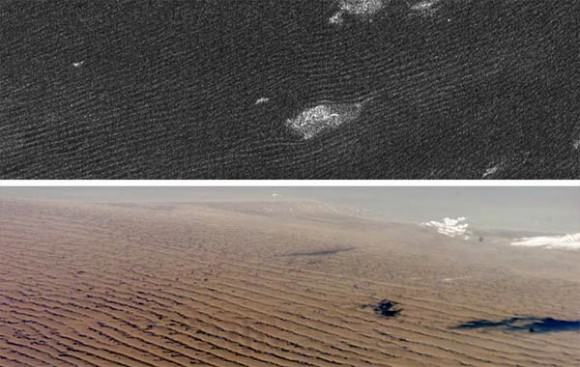Titan is Saturn’s largest moon and is constantly surprising scientists as the Cassini spacecraft probes under its thick atmosphere. Take its dunes, for example, which are huge and pointed the wrong way.
Why are they pointing opposite to the prevailing east-west winds? It happens during two rare wind reversals during a single Saturn year (30 Earth years), investigators suggest.
Investigators repurposed an old NASA wind tunnel to simulate how Titan is at the surface, watching how the wind affects sand grains. (They aren’t sure what kind of sand is on Titan, so they tried 23 different kinds to best simulate what they think it is, which is small hydrocarbon particles that are about 1/3 the density of what you find on Earth.)
After two years of work with the model — not to mention six years of refurbishing the tunnel — the team determined that the wind must blow 50% faster than believed to get the sand moving.

“It was surprising that Titan had particles the size of grains of sand—we still don’t understand their source—and that it had winds strong enough to move them,” stated Devon Burr, an associate professor at the University of Tennessee Knoxville’s earth and planetary science department, who led the research. “Before seeing the images, we thought that the winds were likely too light to accomplish this movement.”
The winds reverse when the Sun moves over the equator, affecting Titan’s dense atmosphere. And the effects are powerful indeed, creating dunes that are hundreds of yards (or meters) high and stretch across hundreds of miles (or kilometers).
To accomplish this, the winds would need to blow no slower than 3.2 miles per hour (1.4 meters per second), which sounds slow until you consider how dense Titan’s atmosphere is — about 12 times thicker surface pressure than what you would find on Earth. More information on the research is available in the journal Nature.
Sources: Arizona State University and the University of Tennessee, Knoxville.


How did they simulate the 1/7 gee of Titan?
Scale. Gravity can’t scale, but objects and wind speed can scale.
Indeed, gravity does play a role as dune size indicates on Mars and Titan.
“about 12 times thicker surface pressure than what you would find on Earth. ”
No: 1.45 times.
http://en.wikipedia.org/wiki/Titan_%28moon%29#Atmosphere
Who knows what is under Titans huge thick atmosphere there could even be life on Titan this huge moon is not a lot smaller than Mars but has such a thick dense atmosphere which Mars has lost, We really need to probe Titan along with Europa and I hope I am still around when we do eventually get results….
Cassini has mapped the surface extensively with radar showing the above imaged sand dunes along with lakes, rivers, mountain ranges like, Doom Mons…
According to ASU’s article, “they compensated for the low density of Titan sand and the moon’s reduced gravity through numerical modeling.” Yes, I know, not a very satisfying answer. I’d like to see a micro-wind tunnel experiment fly on a zero-g flight (but at Titan’s gravity) to really see what happens (and try various adhesives on the particles, as they may be sticky on Titan). 🙂